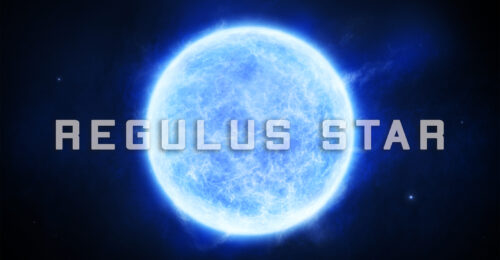A celestial spectacle of unparalleled brilliance awaits us in the evening sky on July 28, 2023. Nature’s grand theater will unveil a breathtaking cosmic display as a royal blue star, Regulus, and the dazzling planet Mercury align in perfect harmony.
This enchanting celestial encounter presents a rare opportunity for stargazers and astronomy enthusiasts to witness a captivating juxtaposition of two celestial bodies, each illuminating the vast expanse of the heavens in its unique way.
The universe has always been a canvas of wonders, and observing celestial events such as this fills us with a sense of awe and insignificance. Regulus, a prominent luminary in the constellation Leo, holds a place of great significance in ancient mythology and has been revered across cultures throughout history. Its name, meaning “Little King” or “Heart of the Lion,” aptly reflects its prominence and regal allure in the night sky.
Sitting in proximity to Regulus on this particular evening is Mercury, the smallest and innermost planet in our solar system. Known as the “Swift Messenger of the Gods” in Roman mythology, Mercury’s rapid orbit around the sun is a sight to behold, making its appearance next to the majestic Regulus even more captivating.
The alignment of these two celestial bodies is a testament to the precision and harmony that governs the cosmos. It is an opportunity for us to reflect on the beauty of the universe and our place within it. From ancient civilizations to modern-day astronomers, such celestial events have sparked curiosity and inspired profound contemplation about the mysteries of the cosmos.
Whether you’re an experienced astronomer or a casual stargazer, the evening of July 28, 2023, presents an unmissable chance to witness the dance of Regulus and Mercury in the evening sky. Armed with a telescope or simply relying on the naked eye, this celestial rendezvous is sure to leave an indelible mark on our souls and reaffirm the timeless wonder that lies just beyond our atmosphere.
So, let us attune our eyes to the heavens on this remarkable night and revel in the beauty of Regulus and Mercury as they adorn the celestial tapestry, reminding us of the grandeur that resides beyond our world. As we delve into the captivating celestial events of July 28, 2023, let us embrace the majesty of the cosmos and ponder the vast mysteries that continue to inspire our pursuit of knowledge and understanding.

Viewing Tips On How to See Regulus
Here are viewing tips, plus learn about the remarkable Regulus, the “little king” of the stars.
On July 28, you’ll need an unblocked western horizon. After sunset:
- Look first very low near that horizon for the elusive orange planet Mercury which is the brighter of the two at +0 magnitude.
- Then look very, very close to Mercury (only 0.1 degrees apart!) for the famous blue star Regulus (+1.3 magnitude). They form such a close pairing that they’re about the equivalent distance of 1/5 the diameter of a full Moon!
- On July 28 the night sky will have venus, regulus, and mercury.
- The July 28 Night Sky lets you see the orange planet, Mercury, pair up with the bright blue star, Regulus.
Binoculars will make the pastels pop. But such optical aid is icing on the cake: anyone visually searching the low western horizon will see that striking planet-and-star combo just as twilight begins to fade. See planet Mercury rise and set times.
Regulus is one of the brightest stars in the night sky. And while it appears as a single star to the human eye, Regulus has three unseen companion stars, two of which can be seen in telescopes.
Regulus is also the brightest object in Leo. The “Sickle of Leo” makes up the lion’s mane and looks like a backward question mark of stars.
Regulus sits prominently at the base of that “sickle” or reversed question mark, all of which makes Leo one of the relatively few constellations that actually resembles what it’s supposed to portray.

Regulus, the Little King
The lion, of course, represents the noble king of the beasts. And Regulus means “little king” in Latin. Regulus has been famous through the ages, regarded by the ancient Persians, for example, as one of the “four royal stars.” The “little king” was viewed as the most important of the Four Royal Stars of the Persians, which marked the seasons.
Its fame is largely due to its position almost smack on the ecliptic, the center of the zodiac! This means that as the Sun circles around the sky each year, passing repeatedly in front of the same constellations that were deemed super special for untold thousands of years, it comes closer to Regulus.
The Sun’s motion against the stars is of course due to Earth orbiting around it, giving the Sun a different daily background from our perspective as it shifts one degree (two Sun-widths) per day. We never actually see this because the Sun’s brilliance makes the sky blue and renders invisible everything behind it. Only during a total solar eclipse can we view the stars behind the Sun.
Yet the ancient Babylonians, 4,000 years ago, observing the stars somewhat near the Sun each day just before dawn and again at nightfall were able to determine the Sun’s daily path and position to a high degree of precision. They discovered the constellations through which the sun passed and called them the zodiac.
They knew that only six bright stars in a few of those zodiac constellations could ever appear next to the Sun, Moon or planets. Of those, Regulus in Leo the Lion was far-and-away the closest star to the Sun’s precise yearly path, the ecliptic.
Look For Regulus Again on August 22
The Sun skims a mere one degree from Regulus each year on August 22. The planets, too, being aligned in nearly the same flat plane as the Earth-Sun orbit, periodically pass very near Regulus. The meetings are often spectacular, like the one now involving Mercury.
But an even more eye-catching Regulus conjunction will unfold on June 16, 17, and 18, 2025. Orange Mars will closely hover next to blue-white Regulus right after nightfall, and that time there’ll be no need for a oceanic, unobstructed western horizon. Then, the Mars-Regulus pair will hover a comfortable 20 degrees high.
Facts About Regulus The Star
Leaving mythology and the free-associative realm of constellation-drawing, the actual physical star Regulus is a commanding presence 85 light-years away.
Its blue color—one of only five obviously blue stars visible over the US and Canada—reveals a sizzling temperature too hot to have the vaporous metals our own Sun possesses on its gaseous surface.
A hefty five times bigger than our own Sun, and hovering in a direction aimed away from our galaxy’s center, Regulus is slowly receding from Earth at the leisurely rate of two miles a second.
Regulus is neither dazzling nor is it a slouch, as it holds 16th place among the brightest stars seen from north temperate countries. But its main claim to fame is its fortunate position aligned with the plane of our solar system, letting our earthly eyes watch it periodically meet the Moon and planets, and even infrequently to be eclipsed by them.
On July 7, 1959, European observers saw the planet Venus pass directly in front of Regulus, an occultation whose rarity is obvious when one realizes that any planet blocking any bright star is unlikely to happen in the average lifetime. Nonetheless, in a stupendous turn of events, there will indeed be a planet/star occultation this very century. Again it will be Venus, and again it will be Regulus, when that nearest and brightest planet totally eclipses the “Royal Star” on October 1, 2044.
In closing, the evening of July 28, 2023, promises to be an extraordinary night for stargazers and dreamers alike. As we turn our gaze upwards, we are reminded of the boundless wonders that lie above us and the infinitesimal nature of our own existence in this vast and mysterious universe.
The celestial alignment of Regulus, the royal blue star, and Mercury, the swift messenger of the gods, offers us a rare and awe-inspiring sight—one that invites us to pause, reflect, and marvel at the harmony and precision of cosmic dance.
In the fast-paced world we live in, taking a moment to connect with the cosmos can be a profound and grounding experience. The celestial spectacle unfolding above serves as a gentle reminder of our place in the cosmos, humbling us with the realization that we are just a tiny speck in the grand tapestry of the universe.
As we witness Regulus and Mercury gracing the evening sky, let us embrace the sense of wonder that comes from contemplating the unknown. Just as ancient civilizations looked to the stars for guidance and inspiration, we too can find solace in the beauty and mystery of the cosmos.





